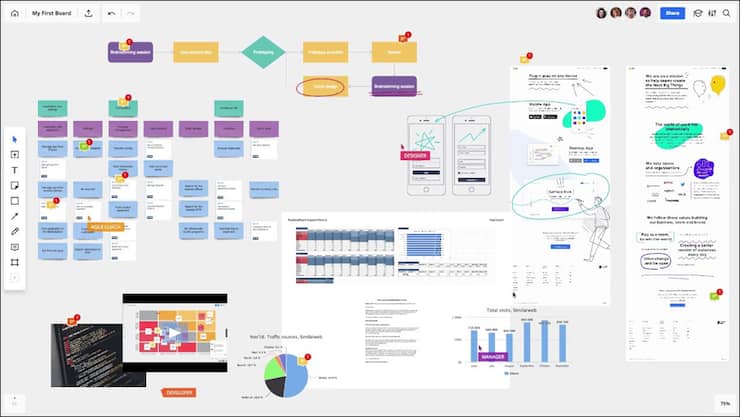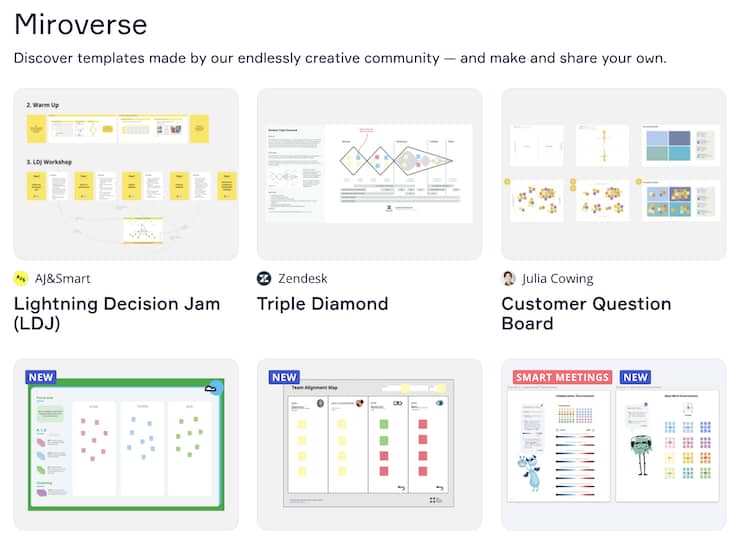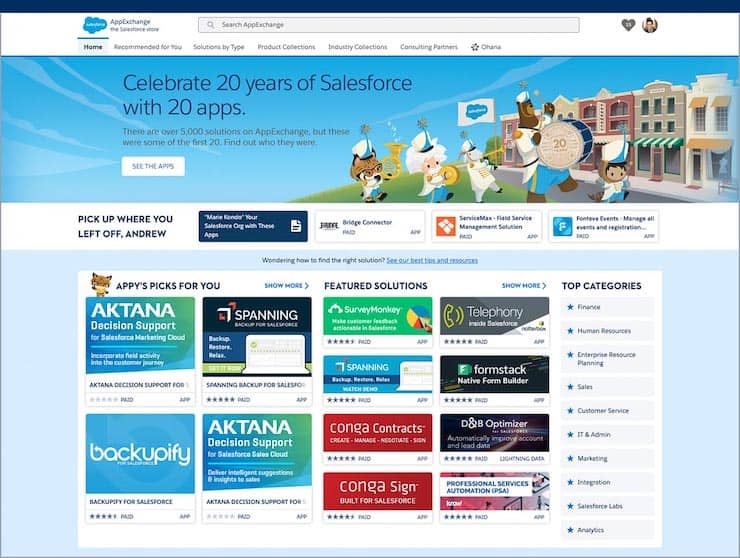
A few years ago, we at RE’FLEKT shaped our vision to build a kind of operating system for enterprise AR. Not an OS for hardware, but a modular software and application platform with built-in user collaboration. Our vision was to use modules and blocks from different software eras that have proven successful.
Besides the modular building blocks structure, we identified collaboration between teams, customer-built content, and crowdsourced tools as key ingredients for 10x product experience and scale. We’re not 100 percent there, but we can see the impact of adding viral growth effects to our products.
Question: How can AR/VR software companies bake collaboration into their products and customer-built templates to fuel growth?
In this article, I want to show the power and opportunity behind companies that integrate collaboration into their products and involve customers and the crowd in the development of building blocks and templates. The building blocks “collaboration-powered”, “customer-built” and “crowdsourced” can be baked into any enterprise software or SaaS product.
Of course, I know that some of the examples in this article are low-barrier and no-touch products, relative to the complexity often seen in enterprise software. And yes, collaboration and viral growth have origins in the B2C sector.
This is why it is a great opportunity for B2B – especially enterprise and high-tech – to stand out from usual sales-led top-down approaches. Adding viral features throughout your product will naturally allow it to expand after landing a new account.
Let’s build a modular operating system and learn from the most successful software companies.
Model platforms have a few key components. They have integrated applications like Google and Microsoft. Like Salesforce, they can have app stores that are propelled by creators. Software development kits meanwhile offer core functionality for personalized development. Connective tissue can be gained through integrations similar to Zapier. And intuitive collaboration and file handling can be modeled after tools like Trello, Miro, and Dropbox.
Technologies with steeper learning curves and higher complexity conversely do not show the same growth rates. So we have learned to make our products more collaborative, like the above examples. This also requires giving users the opportunity to share feedback, invite colleagues, and have as many pre-prepared workflows and templates as possible. All of these factors can lead to faster growth and virality.
Viral growth — specifically the type baked into product features, in the form of invites, sharing, and collaboration — is a topic I’ve been endlessly fascinated by. It’s the central force that has propelled many of the world’s most popular products to billions of users.
ANDREW CHEN, PARTNER, ANDRESSEN HOROWITZ
What are the key challenges for Emerging Tech solutions like AR and VR?
A look at the AR market shows that content creation, content management, and content delivery occupy the most important position (next to games). The challenges for application creators include hurdles for faster tech adoption and product growth. Here are a few examples:
Content creation can be time-consuming due to steep learning curves and required knowledge in handling 3D files. While everyone can easily log into virtual design tools like Figma or Canva and build a website page, stripping CAD files and modeling 3D formats can cause serious headaches.
A-ha moments are blurry because of friction in the product experience, which affects the time to value and user activation. Creators have to go through demos and workshops before actually using the product. End-users must find the right surface or use so-called “ghost models” to activate content.
High-touch products need hand-holding and education. Typical top-down sales motion is standard for these products, as is demo requests through sales channels. Personal onboarding can be a blessing, but it increases acquisition costs and might add friction to the product experience.
Collaboration is not built-in. Often, tools are focused on a single user: the content creator. Products do not have active user invitations or share and rate mechanisms to enable viral growth loops.
Building starts from scratch. Modern creation and collaboration tools like Canva, Figma, or Miro use templates to allow a quick start. Starting from scratch and doing single steps for everything feels like using PowerPoint in 1998.
How does AR and VR creator software compare with hyper-growth companies?
A look at the user numbers shows the huge differences between AR creation tools and rapidly-growing collaboration tools. The most popular AR creation software is Unity3D with 1.5 million monthly active users (MAU), the majority of which come from the gaming sector.
Rapidly growing design, creation, and collaboration tools like Figma and Canva reach approximately 25 million MAU and 50 million MAU, respectively, and grew to those numbers in a shorter time. Is it fair to compare easy-to-use no-code creation and collaboration tools with AR/VR low-code tools? Maybe not at first sight. Can AR/VR tools use the same mechanisms and triggers to grow faster? I believe that the answer can be yes.
Faster growth in a shorter time is not only due to easier access, but the ability to work with different teams on projects and trigger viral loops through a 10x product experience. Templates and building blocks make the work faster, easier and more fun, which users love to talk about. Here are five reasons why hyper-growth companies increase their user base and revenue faster than average.
- Reducing the entry-barrier caused by a steeper learning curve through coding with templates and letting (well-known) customers share their benchmark examples
- Increasing collaboration through involving different teams and members, instead of only focusing on the creator
- Getting product usage data to understand what users actually expect in the product, and also how to use the right value metrics
- Applying freemium models where users can test and explore quickly without going through IT or their own management
- Focusing on onboarding to establish a habit of using your product and then reach the “a-ha” moments quickly, to avoid churn and low retention
One player that’s demonstrating these tactics has a strong VR focus and is setting out to conquer the software world: Nvidia. It recently announced that its Omniverse platform is not only aimed at developers but also at creators and artists. For this, a freemium model was introduced – a good first step.
In an article on VentureBeat, Richard Kerris, VP of Omniverse platform, explained: “We look at it as the same context as an operating system. A rising tide lifts all boats. There will be many avenues for commerce on these virtual worlds. We think there is an entire economy coming for these virtual worlds. The more we can make it available, the better all of us can benefit.”
Increase engagement and growth with collaboration and customer-built models.
When we talk about collaboration in the context of user engagement and growth, it’s primarily about how the involvement of multiple users working on a project can be used as a growth trigger.
Let’s take Figma as an example. The design tool naturally started with designers. When they extended the tool to marketing teams, project managers, and engineers, the growth started because teams could then collaborate on projects. Project participants quickly saw the advantage in ease of use, and then invited other team members.
The product effectively becomes a sales and marketing collaborator. Miro, a virtual whiteboard and collaboration tool, grew on the same pillars. In addition, there was the clever move not only to offer their own templates but to encourage customers, users, and partners to upload their boards for use by other teams.
1. Collaboration-powered products grow faster
Playing games alone is okay. Playing games together with others is more fun. Not only do you achieve something together, but you can also learn tricks from each other.
The same principles apply at work. A Stanford University study showed that simply feeling like you’re part of a team of people working on a task makes people more motivated as they take on challenges. Participants in the research who were primed to act collaboratively stuck at their task 64 percent longer than their solitary peers, whilst reporting higher engagement levels, lower fatigue, and a higher success rate.

With CRM software, remote support, or project management, collaboration is obvious. For other products such as content tools or data solutions, the traditional model is there – one person builds something, the others get to use it. Why not involve different stakeholders and teams directly, enlarge the target group, and increase engagement – and thus value – for the company?
How Collaboration improves user adoption and viral growth
In our remote tool, we have introduced a “Guest Access” with which customers can invite their customers to solve problems together. Importantly, Guest Access can be converted into a full account, similar to a freemium approach. The idea was to reduce barriers to adoption and motivate teams to invite colleagues and customers. Enterprise products often limit themselves because of onboarding, approvals, and access. This should be avoided, to elevate existing users and the product itself as sales channels.
In summary, here are some advantages to this approach:
- Productivity can be increased for customers through internal and external collaboration.
- User adoption is higher due to engagement levels versus single-user products.
- Word-of-Mouth and viral loops can be used to grow the user base, and establish new habits.
- Purchase and expansion/upgrade decisions are easier on customers given team commitment.
- A rapidly-increasing user base helps to create stickiness and product defensibility.
In a nutshell, enable your product to grow through your users. Implement mechanisms and triggers that allow users to invite others, to collaborate, and share their work. Users are in the product every day, every week: there’s no better place to engage with and motivate them to use even more of the product.
2. Customer-built templates and workflows reduce friction.
We want our users to quickly see the value of our product in order to reach the “a-ha” moment. That’s the goal of a successful onboarding program. But what if users have to start from scratch again and again….like an Excel spreadsheet without templates? Or think about PowerPoint 15 years ago, where you couldn’t group assets to apply the same actions. What an awkward experience.
Templates are now standard for many tools in order to get started faster. There are several enterprise products where this is not the case: because data or models are needed, or because customer use cases are varied.
Every product needs templates and building blocks that can be used directly by new users or serve as samples. Before Figma, designers went to Pinterest for inspiration; and data nerds looked at other users’ Excel sheets.
Customers build and share community templates
So why not let customers build templates and building blocks? They know what they need, and they then develop workflows, models, and content that is actually in use. That’s what we call “customer-built.”

In the initial phase, the collaboration tool Miro allowed its users to provide their own templates in the library. In the meantime, this has become its own space: the Miroverse. It contains templates from individual users as well as from companies such as Dropbox, Deloitte, and Atlassian.
Involving customers and users in building templates and building blocks has an impact on your product onboarding, UX, and customer relationships. In addition to collaboration, this is also a growth accelerant through viral loops and network effects.
Here are a few ways this can happen:
Teams can provide their templates in an internal space if it is not possible to publish them. The internal space can also be used for communication within the company.
Customers can share their work on your building blocks and template space to help other users onboard easier.
Use brand effect and word-of-mouth through content or blocks built by known brands, which leads to trust and creates a movement: “I want to be part of it”.
Reward users and customers for sharing templates and workflows, depending on their financial, social, or professional motivation (visibility, awards, beta tester, etc.).
Use the product and engagement data to understand which templates are used most, what kind of use cases are behind it, and how users are building content.
David Petersen, Partner at Angular Ventures, describes “customer-built” as a growth model – one that works especially well for products that can be customized.
Customer-built products empower end-users to remix a product’s building blocks to design (and sell) their own tools. What if a customer-built product made it possible for end users — even non-technical end-users — to design the building blocks themselves? As an example, what if Excel (the original and best customer-built product, in my opinion!) had a formula platform that enabled any user to develop more complex meta-formulas and publish them so they’d be available to all users? This could create the opportunity for tight incentive alignment between the company and early builders and network effects (more builders = deeper, more expansive, more useful product).
3. Crowdsourced portfolio to connect and integrate
There is a lot of expectation on companies when it comes to product development, especially for startups. Yet that’s precisely where it’s most important to focus on one’s own strengths and to not be distracted.
An essential part of rapid software growth is integration and interaction with other solutions that are already available to the customer. These can be well-known tools such as Salesforce and Zendesk, but also internal solutions.
When I was at Hyperloop, we had a crowd-sourcing approach. We wanted to integrate and use the best solutions on the market. Similar to open-source models, we enabled collaboration between different creators and builders. At Reflekt, we focused early on modularity interoperability to combine tools quickly and easily.
Crowd-sourcing adds value to the portfolio and helps other builders to generate revenue
Salesforce started early to build AppExchange, a platform where developers and companies can offer their own tools for the Salesforce world. All fast-growing platforms and ecosystems have their own marketplaces for integrating products that they don’t develop themselves, but that customers need.

Figma’s growth is based on its collaborative functionality and the ease-of-use. And the fuel for growth is the crowd and community. Shortly after launching its platform, more than 700 third-party plugins have been built, with more than 3 million installs.
The crowdsourcing approach is an extension of collaboration and customer-built to engage a larger community. As a product provider, we can provide a platform for developers and startups to generate revenue.
 Dirk Schart is CMO at RE’FLEKT where he helped lead the work augmentation platform into the No. 1 “best in class” Enterprise AR startup according to ABI Research. Follow him on Twitter at @DirkSchart.
Dirk Schart is CMO at RE’FLEKT where he helped lead the work augmentation platform into the No. 1 “best in class” Enterprise AR startup according to ABI Research. Follow him on Twitter at @DirkSchart.
Header image source: Ash Edmonds on Unsplash






